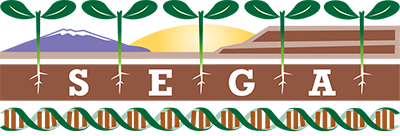You are here
AZCC collaboration makes space for ponderosa experiment at The Arboretum
AZ Conservation Corp (https://azcorps.org/ (link is external)) members have been thinning trees at The Aboretum at Flagstaff over the winter. In a synergistic collaboration with SEGA, AZCC felling teams have been getting valuable training experience – and helping make space for more SEGA research.
A number of ponderosa pines that previously formed a fairly dense uniform stand have been removed from SEGA’s forest enclosure on the south side of the grounds of The Arboretum at Flagstaff, while leaving larger older pines in place. The newly created space is making way for additional plantings of south western white pine seedling in raised boxes (part of a major study led by NAU Professors Kristen Waring & Amy Whipple) – as well as new ponderosa pine seedlings.
Professor Tom Kolb (NAU Forestry) and his graduate student Aalap Dixit will be planting the new ponderosas as part of a study to identify which genetic strains of ponderosa pines are most arid-adapted. The research will:
1) Identify ponderosa pine populations in the southwestern US most suitable for future reforestation projects in increasingly arid conditions; and
2) Investigate which traits in ponderosa pine are most strongly associated with that genetic adaptation to succeed in dry conditions.
Ponderosa pine seedlings from 22 provenances will be planted at the Arboretum Forest site, along with the same number at SEGA’s Blue Chute site located north of the peaks off Highway 180. In early summer this year, competing vegetation will be removed from the sites, along with logs, other coarse woody debris, and surface rocks, to facilitate planting.
Approximately 1200 seedlings will be planted at each site in a randomized block design; this will be done in late summer to take advantage of late summer monsoon rainfall. Seedlings will be watered by hand when planted but after that will be left to fend for themselves and survive from incoming precipitation. That could stretch the young ponderosas’ ability to survive at the Blue Chute site – which at an elevation of 6, 332 ft (1,930 m) above sea level is currently pinyon-juniper habitat.
“We may get a fair bit of mortality at the Blue Chute site” says Prof. Kolb - “the conditions there are right at the edge of what ponderosa pines are thought to be able to tolerate, so it will be a great test”. The seedlings are being grown from trees that span a range of natal habitats and climatic regimes within the species’ range.
The project is planned to last for between three and five years, depending on seedling survival and contingent on project funding – which is from the NAU School of Forestry Mission Research Board (USDA/AZ Bureau of Forestry funds). Dr. Owen Burney at New Mexico State University and Manager of the Mora Tree Nursery is also collaborating with the research - providing greenhouse-grown seedlings and assisting with planting.
If you’re interested in the possibility of carrying out research with SEGA, don’t hesitate to contact SEGA Project Manager Dr Diane Hope di.hope@nau.edu (link sends e-mail). You can find detailed site information for each of the 10 core sites at our ‘Gardens’ web page: http://www.sega.nau.edu/gardens
Theme by Danetsoft and Danang Probo Sayekti inspired by Maksimer
